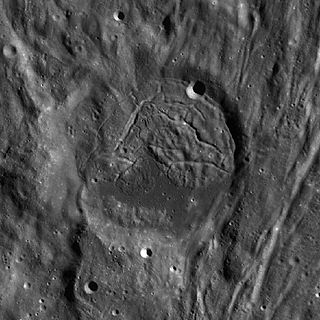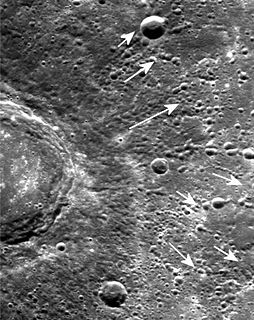
Capella is a lunar impact crater 49 km (30 mi) in diameter that lies to the north of the Mare Nectaris, in a rugged region with many small impact craters. It was named after Roman astronomer Martianus Capella. It intrudes slightly into the eastern rim of the crater Isidorus, a feature only slightly smaller in diameter.

Baade is a lunar impact crater that is located near the southwest limb of the Moon on the near side, to the southwest of the enormous Mare Orientale impact basin. The area to the east of this crater forms the junction between the 280-km-long Vallis Bouvard to the north and the narrower, 160-km-long Vallis Baade to the south-southeast. Both valleys radiate away from the impact basin to the north.

Shaler is a lunar impact crater that lies on the southeast interior edge of the Montes Cordillera mountain ring that surrounds the immense Mare Orientale formation. It is located near the southwest limb of the Moon on the near side, and so is viewed nearly from on edge from the Earth. Just to the northwest of the crater is the slightly smaller crater Wright.

Bohr is a lunar impact crater that is located near the western lunar limb, in the area that is affected by librations. It is attached to the southwestern rim of the larger, eroded Vasco da Gama formation, and to the southeast of the crater Einstein. The crater was observed for the first time in 1963 by Arthus and Ewen Whitaker in the book Rectified Lunar Atlas.

Drude is a lunar impact crater that lies on the far side of the Moon, in the rugged Montes Cordillera range that forms the outer ring around the Mare Orientale impact basin. It is located just behind the west-southwest limb, and this area is sometimes brought into sight from Earth during favorable librations. However, even at such times, the crater is viewed from the edge and little detail can be seen.

Chadwick is a lunar impact crater that lies on the far side of the Moon's surface, just beyond the southwestern limb. It is located to the northwest of the crater De Roy, and was previously designated De Roy X before being given its current name by the IAU. This region of the lunar surface lies at the southern end of the ejecta blanket that surrounds the Mare Orientale impact basin.

Couder is a small lunar impact crater that is located just behind the western limb of the Moon, in a region of the surface that is brought into view during favorable librations. It lies on the inner foothills of the Montes Cordillera, a ring-shaped mountain range that surrounds the Mare Orientale impact basin.

Inghirami is a lunar impact crater that is located toward the southwestern limb of the Moon. It lies to the southwest of the large walled plain Schickard. Northwest of Inghirami is the wide Vallis Inghirami, a wide, straight valley that is radial to the Mare Orientale impact basin. The valley has a length of about 140 kilometers and ends at the northern edge of the crater.

Montes Cordillera is a mountain range on the Moon. This feature forms the outer wall of peaks that surround the Mare Orientale impact basin, the inner ring being formed by the Montes Rook. The center of the range is located at selenographic coordinates 17.5° S, 81.6° W, and the diameter is 574 km (357 mi).

Eichstadt is a lunar impact crater that is located in the eastern section of the Montes Cordillera range that encircles the Mare Orientale impact basin. It lies toward the southwestern limb of the Moon, and so appears oblong when viewed from the Earth due to foreshortening. Over 200 kilometers to the east of Eichstadt are the craters Darwin and Lamarck, and to the south is Krasnov.

Graff is a small lunar impact crater that lies along the southwestern limb of the Moon. It is located to the west of the Vallis Bouvard depression in the southern part of the ejecta blanket that surrounds the Mare Orientale impact basin. To the south-southwest is the smaller crater Catalán.

Chalonge is a lunar impact crater that is located on the far side of the Moon. It lies to the southwest of the larger crater Lewis, in the outer skirt of ejecta that surrounds the Mare Orientale impact basin. To the southeast are the Montes Cordillera, a ring of mountains that encircle the Mare Orientale formation.

Elvey is a lunar impact crater that is located on the far side of the Moon. It is located near the northern edge of the blanket of ejecta that surrounds the Mare Orientale impact basin. To the north of Elvey is the smaller crater Nobel.

Fényi is a small lunar crater on the far side of the Moon. It lies near the southern edge of the huge, braided skirt of ejecta that surrounds the Orientale impact Basin to the north. Less than two crater diameters to the southwest is the much larger crater Mendel.

Fridman is the remains of a lunar impact crater on the far side of the Moon. It lies due south of the huge walled plain Hertzsprung, and is attached to the northeastern rim of the crater Ioffe.

Sundman is a lunar impact crater that lies just past the western limb of the Moon. Although it lies on the far side from the Earth, this part of the surface is brought into view during periods of favorable libration and illumination. Sundman lies to the southwest of the walled plain Einstein, and to the west of the Vallis Bohr cleft. It was named after Finnish mathematician and astronomer Karl F. Sundman.
Vallis Baade is a 203 km long sinuous valley on the Moon running south-southeast from the crater Baade and centered at 45.9°S 76.2°W. It has the same namesake as the crater, the German astronomer Walter Baade.
Vallis Bouvard is a 284-km-long valley on the Moon, centered at 38.3°S 83.1°W. It begins at the southern rim of the crater Shaler, and winds its way to the south-southeast towards Baade. This is one of several such valleys that radiate away from the southeast edge of the Mare Orientale circular impact basin, the other two being Vallis Inghirami and Vallis Baade. It was formed by a secondary crater chain. The valley was named after Alexis Bouvard.

The Mendel-Ryberg Basin is a Nectarian impact basin on the southwestern limb of the moon. It is named after the crater Mendel on the west margin and the smaller crater Rydberg north of the center of the basin. The basin is due south of the larger, younger Orientale basin, and ejecta and other geomorphological effects from the younger basin have overprinted the older one.





















